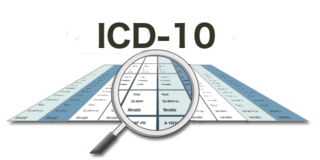The International Classification of Diseases (ICD) is a globally used medical classification used in epidemiology, health management and for clinical purposes. The ICD is maintained by the World Health Organization (WHO), which is the directing and coordinating authority for health within the United Nations System. The ICD is originally designed as a health care classification system, providing a system of diagnostic codes for classifying diseases, including nuanced classifications of a wide variety of signs, symptoms, abnormal findings, complaints, social circumstances, and external causes of injury or disease. This system is designed to map health conditions to corresponding generic categories together with specific variations, assigning for these a designated code, up to six characters long. Thus, major categories are designed to include a set of similar diseases.

Medicare is a government national health insurance program in the United States, begun in 1965 under the Social Security Administration (SSA) and now administered by the Centers for Medicare and Medicaid Services (CMS). It primarily provides health insurance for Americans aged 65 and older, but also for some younger people with disability status as determined by the SSA, including people with end stage renal disease and amyotrophic lateral sclerosis.
The Major Diagnostic Categories (MDC) are formed by dividing all possible principal diagnoses into 25 mutually exclusive diagnosis areas. MDC codes, like diagnosis-related group (DRG) codes, are primarily a claims and administrative data element unique to the United States medical care reimbursement system. DRG codes also are mapped, or grouped, into MDC codes.
Case mix, also casemix and patient mix, is a term used within healthcare as a synonym for cohort; essentially, a case mix groups statistically related patients. An example case mix might be male patients under the age of 50, who present with a myocardial infarction and also undergo emergency coronary artery bypass surgery.

Mark Barr McClellan is the director of the Robert J Margolis Center for Health Policy and the Margolis Professor of Business, Medicine and Health Policy at Duke University. Formerly, he was a senior fellow and director of the Health Care Innovation and Value Initiative at the Engelberg Center for Health Care Reform at The Brookings Institution, in Washington, D.C. McClellan served as commissioner of the United States Food and Drug Administration under President George W. Bush from 2002 through 2004, and subsequently as administrator of the Centers for Medicare and Medicaid Services from 2004 through 2006.
A Federally Qualified Health Center (FQHC) is a reimbursement designation from the Bureau of Primary Health Care and the Centers for Medicare and Medicaid Services of the United States Department of Health and Human Services. This designation is significant for several health programs funded under the Health Center Consolidation Act.
A medical classification is used to transform descriptions of medical diagnoses or procedures into standardized statistical code in a process known as clinical coding. Diagnosis classifications list diagnosis codes, which are used to track diseases and other health conditions, inclusive of chronic diseases such as diabetes mellitus and heart disease, and infectious diseases such as norovirus, the flu, and athlete's foot. Procedure classifications list procedure code, which are used to capture interventional data. These diagnosis and procedure codes are used by health care providers, government health programs, private health insurance companies, workers' compensation carriers, software developers, and others for a variety of applications in medicine, public health and medical informatics, including:
Case mix index (CMI) within health care and medicine, is a relative value assigned to a diagnosis-related group of patients in a medical care environment. The CMI value is used in determining the allocation of resources to care for and/or treat the patients in the group.

ICD-10 is the 10th revision of the International Statistical Classification of Diseases and Related Health Problems (ICD), a medical classification list by the World Health Organization (WHO). It contains codes for diseases, signs and symptoms, abnormal findings, complaints, social circumstances, and external causes of injury or diseases. Work on ICD-10 began in 1983, became endorsed by the Forty-third World Health Assembly in 1990, and was first used by member states in 1994. It was replaced by ICD-11 on January 1, 2022.
A case mix group (CMG) is used in patient classification system to group together patients with similar characteristics. This provides a basis for describing the types of patients a hospital or other health care provider treats. Case mix groups are used as the basis for the Health Insurance Prospective Payment System (HIPPS) rate codes used by Medicare in its prospective payment systems.
Severity of illness (SOI) is defined as the extent of organ system derangement or physiologic decompensation for a patient. It gives a medical classification into minor, moderate, major, and extreme. The SOI class is meant to provide a basis for evaluating hospital resource use or to establish patient care guidelines.
APCs or Ambulatory Payment Classifications are the United States government's method of paying for facility outpatient services for the Medicare program. A part of the Federal Balanced Budget Act of 1997 made the Centers for Medicare and Medicaid Services create a new Medicare "Outpatient Prospective Payment System" (OPPS) for hospital outpatient services -analogous to the Medicare prospective payment system for hospital inpatients known as Diagnosis-related group or DRGs. This OPPS, was implemented on August 1, 2000. APCs are an outpatient prospective payment system applicable only to hospitals. Physicians are reimbursed via other methodologies for payment in the United States, such as Current Procedural Terminology or CPTs.

A rural health clinic (RHC) is a clinic located in a rural, medically under-served area in the United States that has a separate reimbursement structure from the standard medical office under the Medicare and Medicaid programs. RHCs were established by the Rural Health Clinic Services Act of 1977, . The RHC program increases access to health care in rural areas by
- creating special reimbursement mechanisms that allow clinicians to practice in rural, under-served areas
- increasing utilization of physician assistants (PA) and nurse practitioners (NP)
A hospital-acquired condition (HAC) is an undesirable situation or condition that affects a patient and that arose during a stay in a hospital or medical facility. It is a designation used by Medicare/Medicaid in the US for determining MS-DRG reimbursement beginning with version 26. Not only hospital-acquired infections but also any other situation or condition, such as pressure ulcers, blood type mismatch, or iatrogenic injury, can be a HAC.
Current Dental Terminology (CDT) is a code set with descriptive terms developed and updated by the American Dental Association (ADA) for reporting dental services and procedures to dental benefits plans. Prior to 2010 many of the codes were published by Centers for Medicare and Medicaid Services (CMS) as HCPCS D-codes under arrangement with the ADA. Ownership and copyright of CDT remained with the ADA. In 2010 the ADA ended the CMS distribution of CDT codes, which can now be purchased from the ADA.
A long-term acute care hospital (LTACH), also known as a long-term care hospital (LTCH), is a hospital specializing in treating patients requiring extended hospitalization. Hospitals specializing in long-term care have existed for decades in the form of sanatoriums for patients with tuberculosis and other chronic diseases. The modern hospital known as an LTACH came into existence as a result of the Medicare, Medicaid, and SCHIP Balanced Budget Refinement Act of 1999. The Act defines an LTACH as “a hospital which has an average inpatient length of stay of greater than 25 days.” Traditionally, LTACHs provide care for patients receiving prolonged mechanical ventilation.
The Expanding Medical and Behavioral Resources with Access to Care for Everyone (EMBRACE) plan is a healthcare system reform proposal introduced by a group called Healthcare Professionals for Healthcare Reform (HPfHR). The plan incorporates elements of private health insurance, single-payer and fee-for-service models in one comprehensive system. It has been referred to as a "Single System" healthcare system. First published in the Annals of Internal Medicine in April 2009, the plan got some early discussion in the healthcare community, but appeared to have come out too late to have had any impact in the development of the Patient Protection and Affordable Care Act (PPACA), the 111th Congress’ landmark health insurance reform legislation. A book outlining the EMBRACE plan in more detail was authored in 2016 by Dr. Gilead Lancaster, a cofounder of HPfHR.
A prospective payment system (PPS) is a term used to refer to several payment methodologies for which means of determining insurance reimbursement is based on a predetermined payment regardless of the intensity of the actual service provided.
Clinical documentation improvement (CDI), also known as "clinical documentation integrity", is the best practices, processes, technology, people, and joint effort between providers and billers that advocates the completeness, precision, and validity of provider documentation inherent to transaction code sets sanctioned by the Health Insurance Portability and Accountability Act in the United States.
A hospital readmission is an episode when a patient who had been discharged from a hospital is admitted again within a specified time interval. Readmission rates have increasingly been used as an outcome measure in health services research and as a quality benchmark for health systems. Generally, higher readmission rate indicates ineffectiveness of treatment during past hospitalizations. Hospital readmission rates were formally included in reimbursement decisions for the Centers for Medicare and Medicaid Services (CMS) as part of the Patient Protection and Affordable Care Act (ACA) of 2010, which penalizes health systems with higher than expected readmission rates through the Hospital Readmission Reduction Program. Since the inception of this penalty, there have been other programs that have been introduced, with the aim to decrease hospital readmission. The Community Based Care Transition Program, Independence At Home Demonstration Program, and Bundled Payments for Care Improvement Initiative are all examples of these programs. While many time frames have been used historically, the most common time frame is within 30 days of discharge, and this is what CMS uses.



